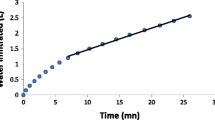Abstract
Laboratory experiments were conducted to examine the growth and reproduction of three deep-burrowing lumbricids, Aporrectodea longa, Lumbricus terrestris, and Octolasion cyaneum. The reproductive output was recorded as 18.8, 38.0, and 32.3 cocoons per worm per year for A. longa, L. terrestris, and O. cyaneum, respectively. For the same species, maturity was reached at a mean mass of 3.9, 5.0 and 2.4 g, within 3 months from the hatchling stage by L. terrestris and within 4 months by the other two species. The hatching success of cocoons at 15 and 20°C was within the range of 70–80% for each species, except A. longa at the higher temperature, where a viability of 47% was recorded. Twenty percent of viable O. cyaneum cocoons produced twin hatchlings, compared with only one percent for A. longa and L. terrestris. A combination of these results suggests that a complete life-cycle for each species could be achieved within 6 months (L. terrestris and A. longa) or 7–8 months (O. cyaneum). Each species has particular life-cycle strategies that would aid survival and colonisation, under field conditions, if inoculated into restored soils.
Similar content being viewed by others
References
Blackshaw RP (1993) Changes in populations of the predatory flat worm Artioposthia triangulata and its earthworm prey in grassland. Acta Zool Fenn (in press)
Brun JJ, Cluzeau D, Trehen P, Bouché MB (1987) Biostimulation: Perspectives et limites de l'amélioration biologique des sols par stimulation ou introduction d'espèces lombriciennes. Rev Ecol Biol Sol 24:687–701
Butt KR (1991) The effects of temperature on the intensive production of Lumbricus terrestris (Oligochaeta: Lumbricidae). Pedobiologia 35:257–264
Butt KR (1993) Utilisation of solid paper mill sludge and spent brewery yeast as a feed for soil-dwelling earthworms. Biores Technol 44:105–107
Butt KR, Frederickson J, Morris RM (1992) The intensive production of Lumbricus terrestris L. for soil amelioration. Soil Biol Biochem 24: 1321–1325
Clements RO, Murray PJ, Sturdy RG (1991) The impact of 20 years' absence of earthworms and three levels of N fertilizer on a grassland soil environment. Agric Ecosyst Environ 36:75–85
Curry JP, (1988) The ecology of earthworms in reclaimed soils and their influence on soil fertility. In: Edwards CA, Neuhauser EF (eds) Earthworms in waste and environmental management. SPB Academic Publishing. The Hague pp 251–261
Curry JP, Boyle KE (1987) Growth rates, establishment and effects on herbage yield of introduced earthworms in grassland on reclaimed cutover peat. Biol Fertil Soils 3:95–98
Evans AC, Guild WJMcL (1947) Some notes on reproduction in British earthworms. Annu Mag Nat Hist 14:654–659
Evans AC, Guild WJMcL (1948) Studies on the relationships between earthworms and soil fertility. IV. On the life-cycles of some British Lumbricidae. Ann Appl Biol 35:471–484
Lee KE (1959) The earthworm fauna of New Zealand. NZ DSIR Bull 130
Lee KE (1985) Earthworms: Their ecology and relationships with soils and land use. Academic Press, Sydney
Lofs-Holmin A (1983) Reproduction and growth of common arable land and pasture species of earthworm (Lumbricidae) in laboratory cultures. Swed J Agric Res 13:31–37
Miles HB (1963) Heat death temperature of Allolobophora terrestris (Sav.) forma longa (Ude) and Eisenia foetida (Sav.)., Nature (London) 199:826
Satchell JE (1967) Lumbricidae. In: Burges A, Raw, F (eds) Soil biology. Academic Press, London, pp 259–322
Sims RW, Gerard BM (1985) Synopses of the British fauna (31)-Earthworms. Linnean Society, London
Soil survey of England and Wales (1984) Soil texture Agricultural Development and Advisory Service. Leaflet No. 895, HMSO, London
Tsukamoto J, Watanabe H (1977) Influence of temperature on hatching and growth of Eisenia foetida. Pedobiologia 17:338–342
Author information
Authors and Affiliations
Rights and permissions
About this article
Cite this article
Butt, K.R. Reproduction and growth of three deep-burrowing earthworms (Lumbricidae) in laboratory culture in order to assess production for soil restoration. Biol Fert Soils 16, 135–138 (1993). https://doi.org/10.1007/BF00369415
Received:
Issue Date:
DOI: https://doi.org/10.1007/BF00369415




